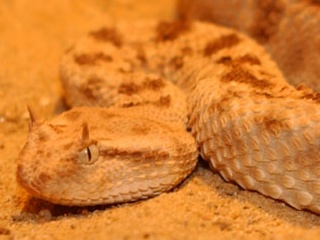|
| Query: Horned sand viper | Result: 2nd of 10 | |
Desert Horned Viper (Cerastes cerastes) - Wiki
| Subject: | Desert Horned Viper (Cerastes cerastes) - Wiki
| |

| Resolution: 320x240
File Size: 35652 Bytes
Upload Date: 2007:02:07 00:07:03
|
Cerastes cerastes
From Wikipedia, the free encyclopedia
[Photo] Cerastes cerastes with horns. Cerastes cerastes, headshot. This image is a small section of [Vipere cornes 24.JPG]. Source http://www.museum.nantes.fr/pages/07-actioneducative/banque.htm Date: 2006-07-02 Author Jwinius (Patrick JEAN / mus??um d'histoire naturelle de Nantes)
Common names: Saharan horned viper, [2] Sahara horned viper,[3] horned desert viper.[4]
Cerastes cerastes is a venomous viper species native to the deserts of Northern Africa and parts of the Middle East. They are ore often easily recognized by the presence of a pair of supraocular horns, although hornless individuals do occur.[2] No subspecies are currently recognized.[5]
Description
The average length is 30-60 cm, with a maximum of 85 cm. Females are larger than males.[2]
One of the most distinctive characteristics of this species are the supraorbital horns, one over each eye. However, these are either present, reduced in size or absent (see Cerastes).[2]
The color pattern consists of a yellowish, pale gray, pinkish or pale brown ground color that almost always matches the substrate color where the animal is found. Dorsally, a series of dark, semi-rectangular blotches run the length of the body. These may or may not be fused into crossbars. The belly is whitish and the tail may have a black tip.[2][3]
Geographic range
Arid north Africa (Morocco, Western Sahara, Mauritania and Mali, eastward through Algeria, Tunisia, Niger, Libya and Chad to Egypt, Sudan, Ethiopia and Somalia) through Sinai to the northern Negev of Israel. In the Arabian Peninsula, it occurs in Yemen and extreme southwestern Saudi Arabia, where it is sympatric with C. gaperettii. A report of this species being found in Lebanon is unlikely, according to Joger (1984). Originally, the type locality was listed only as "Oriente." However, Flower (1933) proposed "Egypt" by way of clarification.[1]
Habitat
Favors dry sandy areas with sparse rock outcroppings. Tends not to prefer coarse sand. Occasionally found around oases and up to an altitude of 1500 m. Prefers coolers temperatures with annual averages of 20°C or less.[2]
Behavior
They typically move about by sidewinding, but instead of sliding sideways on the sand, they press their weight into it leaving whole-body impressions. Often, it is even possible to use these impressions to make ventral scale counts. They have a reasonably placid temperament, but if threatened they may assume a C-shaped posture rapidly rub their coils together. Having strongly keeled scales, this produces a rasping noise, similar to Echis. They are capable of striking quickly.[2]
Reproduction
In captivity, mating was observed in April and always occurred while the animals were buried in the sand.[2] This species is oviparous, laying 8-23 eggs that hatch after 50 to 80 days of incubation. The eggs are laid under rocks and in abandoned rodent burrows. The hatchlings measure 12-15 cm in length.[3]
Venom
C. cerastes venom is not very toxic, although it is reported to be similar in action to Echis venom.[2] Envenomation usually causes swelling, hemorrhage, necrosis, nausea, vomiting and hematuria. A high phospholipase A2 content may cause cardiotoxicity and myotoxicity[3]. Studies of venom from both C. cerastes and C. vipera list a total of eight venom fractions, the most powerful of which has hemorrhagic activity. Venom yields vary, with anything from 19-27 mg dried venom to 100 mg being reported.[2] An estimated lethal dose for humans is 40-50 mg[3].
Taxonomy
A number of subspecies may be encountered in literature:[2]
C. c. hoofieni - Werner & Sivan, 1999 - Saudi Arabia.
C. c. karlhartli - Sochurek, 1974 - South-east Egypt and Sinai Peninsula.
C. c. mutila - Domergue, 1901 - South-west Algeria, Morocco.
Previously, C. gaperettii was also regarded as a subspecies of C. cerastes.[2]
Some think no subspecies are currently recognized.[5]
http://en.wikipedia.org/wiki/Cerastes_cerastes
| The text in this page is based on the copyrighted Wikipedia article shown in above URL. It is used under the GNU Free Documentation License. You may redistribute it, verbatim or modified, providing that you comply with the terms of the GFDL. |
^o^
Animal Pictures Archive for smart phones
^o^
|
|
|